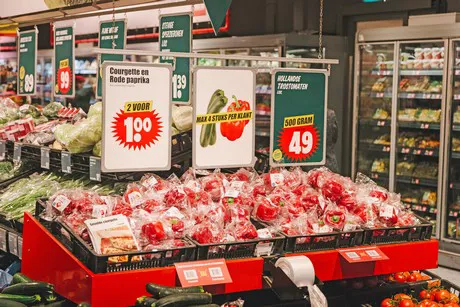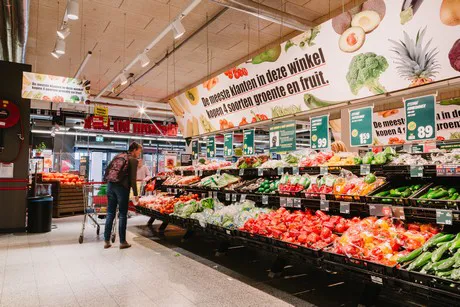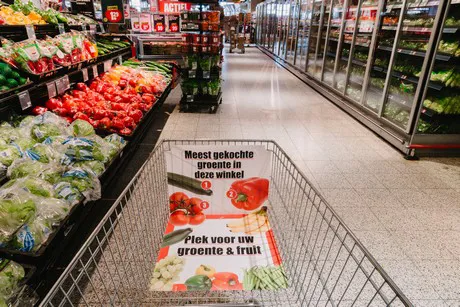Research after research shows that consumers eat too little fruit and vegetables, even though they know how healthy it is for them. Because most consumers get their fruit and vegetables from the supermarket, there is still a lot to gain. But how can supermarkets encourage consumers to buy more fruit and vegetables? The use of nudges is often mentioned, but research into the effects of nudging in retail is still in its infancy. Koert van Ittersum (University of Groningen) and Anne Marie Borgdorff (NAGF) share their experiences.
What is nudging anyway? Nudging is giving a small nudge, a push in the right direction. It is aimed at changing automatic and unconscious choice behavior. Through nudging, people's behavior can subtly be changed without restricting their freedom of choice. An example of a nudge are images of footsteps on the ground that people (unknowingly) follow.
(Un)conscious choices
Koert van Ittersum (RUG), in collaboration with the WUR, is conducting research into ways in which retailers can enable consumers to make sustainable and healthy choices better. The research focuses on choices within product categories. "Retailers posed the question of how they could better help consumers to make conscious choices," says Koert.
“People standing in front of a shelf with products often don’t choose the healthiest or most sustainable option yet. Through research, we hope to better understand what motivates consumers to make these choices (un)consciously. We can then help retailers to respond to this. Perhaps this can be achieved through nudging, but also through, for example, more transparency about the nutritional value of the product.”
Nudging is nothing new within retail: for example, think about the layout of the shelves or the strategic use of color labels, which unconsciously attract consumers to certain purchases. Can the use of nudging also contribute to the sale of fruit and vegetables in the supermarket?
Koert expects that more is needed for this: “We have a nice assortment of fruit and vegetables in our supermarkets and these products are also the first that you see when you walk in. Yet we do not eat sufficient fruit and vegetables. Retailers are currently trying to stimulate sales, but it is not that easy. The disappointing consumption can have many causes, so also different solutions are needed. With nudges alone, we are not going to save the world."

Experiment
Perhaps it will not save the world, but nudges can really make a difference, as the experiment proved that the National Fruit and Vegetable Action Plan (NAGF) had carried out in a Dirk supermarket in 2018. For six weeks the branch was transformed into a ‘Ga voor Kleur Lab’ (‘Go for Color Lab’), in which different combinations of nudges were used to stimulate the sale of fruit and vegetables.
"As far as we know, there has never been a study carried out into the effect of different nudging strategies together with the sale of fruit and vegetables within retail," says Anne Marie Borgdorff, project manager at NAGF. “90% of the vegetables and fruit that consumers eat they bought in the supermarket themselves. We thought: if we can do something at that location, it will immediately follow through."
The nudging experiment proved to be a success. After six weeks, the sale of fruit and vegetables in the ‘Go for Color Lab’ was compared to another Dirk branch in which nudging was not applied. What was the result? Although the sales of fruit and vegetables in both branches were less than in 2017, the decrease in the lab was 6.6%, compared to a decrease of 14% in the supermarket without nudges.
In addition, the decline in sales both before and after the experiment was stronger than during the experiment. Conclusion: a combination of nudges can contribute to the sale of fruit and vegetables within supermarkets. Customers indicated that they did not realize that there were nudges that had directed them unconsciously and had a positive response to the experiment.

Effective nudges
"We regard nudging within retail as an effective means of getting consumers to buy more fruits and vegetables," confirms Anne Marie. “It is important to note that retailers must switch the nudges and not always use the same ones. We also recommend a combination of nudges: individual nudges did not have a demonstrable effect in the experiment."
According to her, it is important that other supermarkets also now start with nudging to stimulate the sale of fruit and vegetables. “We ourselves are talking to two retailers to see what they can do. Many people from the retail sector responded enthusiastically after learning the results, but strangely enough, nudging is not really picked up yet for selling fruit and vegetables.”
She doesn't know what is causing this. “Apparently there is still fear among supermarkets to implement it themselves. If more locations show that it works, you might get a domino effect and more will follow, "she concludes hopefully.
This article was previously published in Dutch in edition 10, 33rd volume of trade journal AGF Primeur. See www.agfprimeur.nl for this.
For more information:
[email protected]
[email protected]
